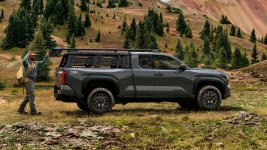Saddle Tramp
Active member
Like most, I have asked myself life's biggest question: Why have pickups gotten so big?
We've heard reasons like bigger radiators creating larger bodies to accommodate them all caused by higher tow ratings, but I think there's a different reason. I am thinking it's because of the growth of compact pickups to mid-sized status. When Ford shifted from the compact sized Ranger to the T6 model in 2012, Ford dropped the Ranger in the US market until the F-150 was "upsized". This size growth, along with the resurgence in the mid-sized pickup market, convinced Ford to bring back the Ranger in 2019.
Doing a trip through Wikipedia, I noticed that pretty much all the mid-sized pickups had hit roughly the same general dimension. (Most likely to creating a global platform for pickups like they did for cars.) Besides looking at the afore mentioned T6 Ranger, I looked up the Chevy Colorado, the Toyota HiLux, the Nissan Navara, the Isuzu D Max and the Mitsubishi Triton.
What I found was that wheelbases ranged from 121 inches to 129 inches with Mitsubishi being an outlier at 118. (Though they did recently up it to 123 inches)
Widths range from 70 to 76 inches with Ford's Ranger reaching up to 79.8 (Most likely bring the Raptor model.)
Height ranges from 67 to 74 inches depending on the model, cab size, and option package.
Let's compare these to the latest, 13th Gen, Ford F-150. Wheelbase is 122.4 to 163.7 inches
Width is 79.9 inches.
Height ranges 75.2 to 76.9 inches.
Rounding we get an average of 125 by 73 by 70.5 for a mid-sized and 142.8 by 79.9 by 76 for a full sized.
That means we are looking at a difference of 17.8 inches for the wheelbase, 6.9 inches for width, and 5.5 inches for height.
How does this measure against an F-150 from the 90's and early 2000's? (Tenth series - built from 97 to 2004) Well the dimensions are 120 to 157 wheelbase, 79.5 inch width, and a height of 73 to 75 inches depending on 2wd or 4wd.
Rounding again we get 138 by 79.5 by 74; or 4.8 inches difference in wheelbase; 0.4 inches for width, and 2 inches difference in height. That's for full sized vs full sized. What's the difference between the tenth gen vs the mid-sized average? Doing the math, we get a difference of 6 inches in wheelbase, 6.5 inches width, and 3.5 inches for height.
Personally. I think it was the 3.5 inch difference in height that did it. Parked side by side you might notice it but parked separately people would definitely ask why you popped extra for the full sized when you could get an "almost same sized" mid-sized pickup.
That's why I think full sized trucks got bigger. So the average person could see the difference. What are your thoughts?
But what about that old Ranger? the 2011 model? Well that measures 111.6 to 125.9 inches in wheelbase, 70.3 width, and 68.3 to 69.4 in height.
Links:

 en.wikipedia.org
en.wikipedia.org

 en.wikipedia.org
en.wikipedia.org

 en.wikipedia.org
en.wikipedia.org

 en.wikipedia.org
en.wikipedia.org

 en.wikipedia.org
en.wikipedia.org

 en.wikipedia.org
en.wikipedia.org

 en.wikipedia.org
en.wikipedia.org

 en.wikipedia.org
en.wikipedia.org

 en.wikipedia.org
en.wikipedia.org
We've heard reasons like bigger radiators creating larger bodies to accommodate them all caused by higher tow ratings, but I think there's a different reason. I am thinking it's because of the growth of compact pickups to mid-sized status. When Ford shifted from the compact sized Ranger to the T6 model in 2012, Ford dropped the Ranger in the US market until the F-150 was "upsized". This size growth, along with the resurgence in the mid-sized pickup market, convinced Ford to bring back the Ranger in 2019.
Doing a trip through Wikipedia, I noticed that pretty much all the mid-sized pickups had hit roughly the same general dimension. (Most likely to creating a global platform for pickups like they did for cars.) Besides looking at the afore mentioned T6 Ranger, I looked up the Chevy Colorado, the Toyota HiLux, the Nissan Navara, the Isuzu D Max and the Mitsubishi Triton.
What I found was that wheelbases ranged from 121 inches to 129 inches with Mitsubishi being an outlier at 118. (Though they did recently up it to 123 inches)
Widths range from 70 to 76 inches with Ford's Ranger reaching up to 79.8 (Most likely bring the Raptor model.)
Height ranges from 67 to 74 inches depending on the model, cab size, and option package.
Let's compare these to the latest, 13th Gen, Ford F-150. Wheelbase is 122.4 to 163.7 inches
Width is 79.9 inches.
Height ranges 75.2 to 76.9 inches.
Rounding we get an average of 125 by 73 by 70.5 for a mid-sized and 142.8 by 79.9 by 76 for a full sized.
That means we are looking at a difference of 17.8 inches for the wheelbase, 6.9 inches for width, and 5.5 inches for height.
How does this measure against an F-150 from the 90's and early 2000's? (Tenth series - built from 97 to 2004) Well the dimensions are 120 to 157 wheelbase, 79.5 inch width, and a height of 73 to 75 inches depending on 2wd or 4wd.
Rounding again we get 138 by 79.5 by 74; or 4.8 inches difference in wheelbase; 0.4 inches for width, and 2 inches difference in height. That's for full sized vs full sized. What's the difference between the tenth gen vs the mid-sized average? Doing the math, we get a difference of 6 inches in wheelbase, 6.5 inches width, and 3.5 inches for height.
Personally. I think it was the 3.5 inch difference in height that did it. Parked side by side you might notice it but parked separately people would definitely ask why you popped extra for the full sized when you could get an "almost same sized" mid-sized pickup.
That's why I think full sized trucks got bigger. So the average person could see the difference. What are your thoughts?
But what about that old Ranger? the 2011 model? Well that measures 111.6 to 125.9 inches in wheelbase, 70.3 width, and 68.3 to 69.4 in height.
Links:

Ford Ranger (Americas) - Wikipedia

Ford Ranger (T6) - Wikipedia

Nissan Navara - Wikipedia

Chevrolet Colorado - Wikipedia

Toyota Hilux - Wikipedia

Isuzu D-Max - Wikipedia

Mitsubishi Triton - Wikipedia

Ford F-Series (thirteenth generation) - Wikipedia



